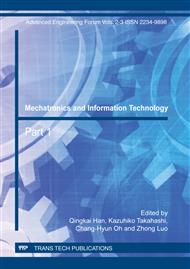p.3
p.7
p.12
p.18
p.24
p.29
p.33
p.39
Application of High-Speed Wind Tunnel Control Based on PID Neural Network
Abstract:
The traditional PID control in nonlinear system such as high-speed wind tunnel has limitations, and the range of using is limited. The BP neural network has been widely applied to the optimization of the PID controller parameter adjustment. The PID neural network control system is introduced in the conventional PID control, which has advantages such as simple structure, physical meaning clear parameters, but also has a neural network of parallel structure and the function of learning and memory and nonlinear mapping capability. The controller uses BP (error back propagation) algorithm to correct connection weights, through on-line training and learning and make objective function to achieve optimal value. This improvement scheme can not only improve algorithm in the training process, and the convergence speed in the wind tunnel, the control valve control system response speed, high precision, meet the steady-state real-time control requirements.
Info:
Periodical:
Pages:
3-6
Citation:
Online since:
December 2011
Authors:
Keywords:
Permissions:
Share:
Citation:


